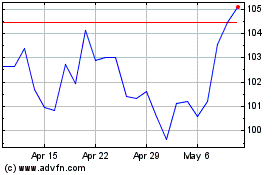By Saabira Chaudhuri
KitKat owner Nestlé SA is upping its game in high-end chocolate
to chase revenue growth as overall chocolate volumes decline.
Global chocolate volumes will be flat this year from a year
earlier and fell 1.1% last year, according to Euromonitor. In the
U.S., the world's largest chocolate market, consumption peaked in
2005 and has declined 3% on average over the past 10 years,
according to UBS. But revenue has grown by 3% a year on average
since 2001, the firm said, as companies have sold health-conscious
shoppers pricier offerings with complex flavor profiles, organic
ingredients and less sugar.
That is forcing mainstream chocolate companies like Nestlé to
shift gears.
On Thursday, Nestlé reported 3.1% organic growth from a year
earlier in its confectionery business for the six months ended June
30, below growth in categories like water, pet care and coffee.
François-Xavier Roger, Nestlé's chief financial officer, called
confectionery "a difficult category," noting that growth was down
year-over-year with "no category growth overall in the U.S."
Overall, Nestlé reported first-half net profit of 4.1 billion
Swiss francs ($4.3 billion), down 8.9% from 4.5 billion francs over
the same period in 2015. Revenue of 43.2 billion francs was
equivalent to organic growth--which strips out the effects of
currencies changes, acquisitions and divestments--of 3.5%, aided by
strong sales in North America. The company has missed its sales
target of organic growth of 5% to 6%--dubbed the "Nestlé
Model"--for three years running, raising questions about its
long-term growth prospects.
The chocolate industry has been consolidating over the past
decade, delivering efficiencies to a handful of big players that
have helped them battle falling volumes. Mondelez International
Inc.'s recent $23 billion bid for Hershey Co. failed, but analysts
expect further consolidation. The top six players control 60% of
the market, according to Euromonitor.
Nestlé, which bought 60% of Chinese candy maker Hsu Fu Chi in
2011, has largely stayed away from making big acquisitions in
confectionery. The company has showed interest in buying Ferrero
International SA but has been unsuccessful so far, leaving its
chocolate portfolio skewed toward mainstream chocolate with brands
like KitKat, Crunch, Butterfinger and Smarties.
As consumers have displayed a taste for upscale chocolate,
Nestlé has worked to position some of its existing brands as
premium offerings in certain markets. KitKat runs stores in Japan
that last year sold a limited-edition version of the chocolate
wafer covered in a layer of real gold foil for Yen2,016 ($20).
More recently, Nestlé has moved to take some of its local
chocolate brands international, highlighting their provenance and
heritage. Consumers, particularly millennials, have an increasing
desire for products with strong local stories.
Nestlé in March said it would invest EUR60 million ($67.9
million) over three years to take its Italian chocolate brand Baci
Perugina global. It agreed to sell six other Italian chocolate
brands to fund its focus on the hazelnut-studded bonbon.
Valeria Norreri--a Nestlé brand manager who worked on the
international rollout of its San Pellegrino water, which now sells
in 145 countries--is heading a new international confectionery unit
that aims to turn Baci Perugina into a global name.
"Sales results of several countries confirm that the product has
the potential to win in foreign markets," she said in March.
Nestlé last year decided to take its almost-200-year-old Swiss
chocolate brand Cailler international, in a bid to enter what it
described as "superpremium chocolate," traditionally the province
of names like Lindt, Godiva and Ferrero. The hazelnut-and-almond
chocolate, made with milk collected within 20 miles of the Cailler
flagship store in Broc, Switzerland, now sells through Amazon.com
Inc. in the U.S., the U.K., Germany and China, and at airports in
Dubai, Singapore and Switzerland.
In February, Nestlé said it was taking its pistachio-laden
Turkish chocolate brand Damak to the U.S. The company described
Damak--which uses pistachios from the Gaziantep region of
Turkey--as "an adventurous taste experience not found in any other
chocolate."
Analysts have criticized Nestlé for its chocolate performance in
recent years, noting its laggard position in the category relative
to its dominance in coffee, water, infant nutrition and other
businesses. The Swiss company's confectionery business, along with
frozen food, also increasingly looks at odds with its ambition to
become a health and nutrition behemoth, leading analysts to suggest
it could eventually look to exit U.S. chocolate. Nestlé didn't
immediately respond to a request for comment.
Hershey, Mars Inc. and Chocoladefabriken Lindt & Spruengli
AG all have bigger U.S. businesses than Nestlé, and Hershey and
Mars have also been pushing into high-end chocolate of late.
Hershey last year launched a deluxe version of its Hershey's Kisses
brand, featuring a hazelnut in the middle and rice crisps. Mars
earlier this year completed a deal to buy Mexican chocolate maker
Grupo Turin, which makes brands like Turin and Conejos and
distributes Lindt in Mexico.
Brian Blackstone contributed to this article.
Write to Saabira Chaudhuri at saabira.chaudhuri@wsj.com
(END) Dow Jones Newswires
August 18, 2016 09:22 ET (13:22 GMT)
Copyright (c) 2016 Dow Jones & Company, Inc.
Nestle (PK) (USOTC:NSRGY)
Historical Stock Chart
From Mar 2024 to Apr 2024

Nestle (PK) (USOTC:NSRGY)
Historical Stock Chart
From Apr 2023 to Apr 2024
